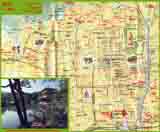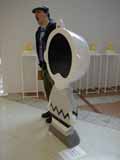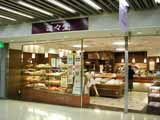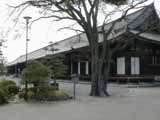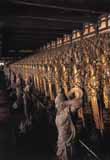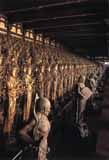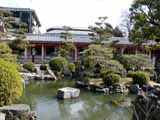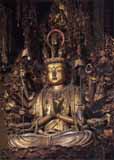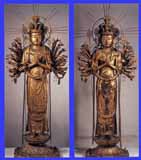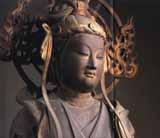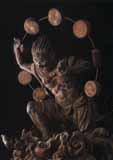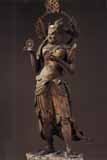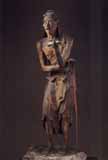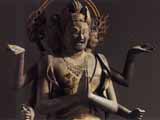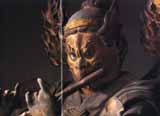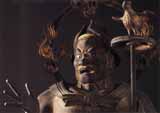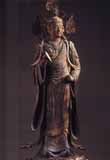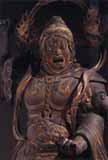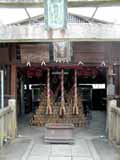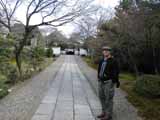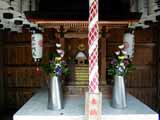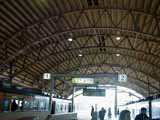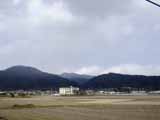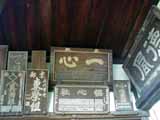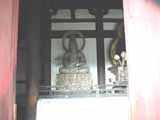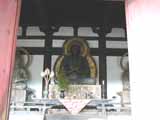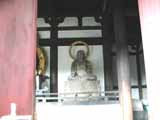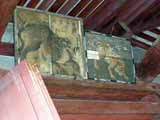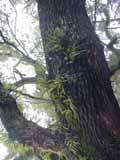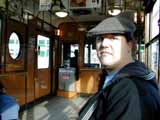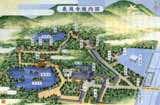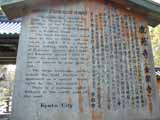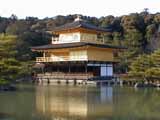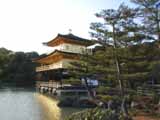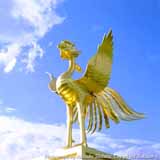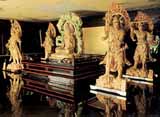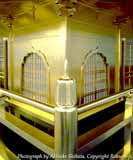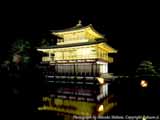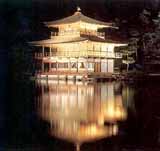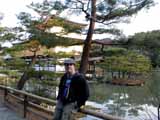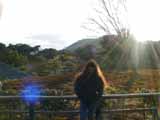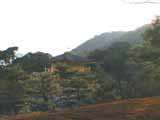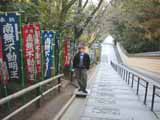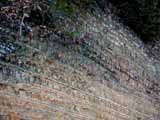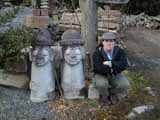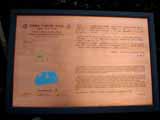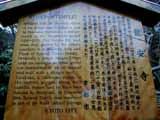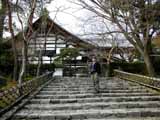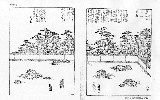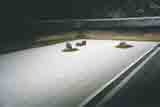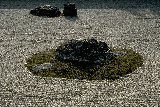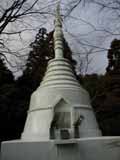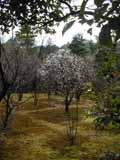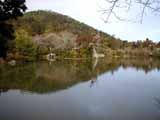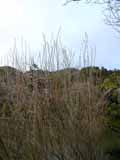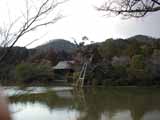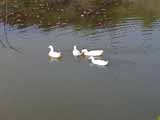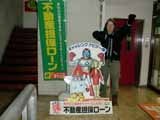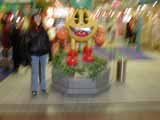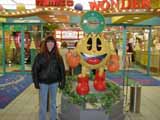We were psyched to awaken to sunny skies this morning -- just the
thing for another day of adventure-seeking! After a leisurely breakfast
in the hotel, we set out for Sanjusangendo. While walking through the underground
(the safest way to cross the busy streets around the railway station!),
we stopped for a quick picture at the ever-changing art exhibition. This
time it was Randy in a silent sympathetic scream with his friend, Charlie
Brown. The statue was captioned 'Godspeed You Charlie Brown.' On
our way out of the subway station, we noticed another branch of the Tsuzuki's
Shin Shin Do, where we stopped off to pick up a few pastries for lunch.
Then it was off through the maze of underground tunnels until we
came up above ground on the far side of the busy traffic surrounding the
transit center at the railway station. The morning sky was bright and half
full of dark clouds that careened across the valley, pushed along by an
icy wind blowing at 10-20 miles per hour. Doing our best to stay in the
shelter of the buildings by taking narrow side-streets, we walked east
across town towards Sanjusangendo, the large temple that was our first
destination on today's informal schedule.
This temple, formally known as Renge-o-in, or 'Temple of the Lotus
King' is popularly called Sanjusangendo for the thirty-three bays of the
main hall. Originally constructed in 1164 AD, it burnt to the ground about
100 years later. Arranged on an extremely long altar within this hall are
1001 statues of Kannon (Avalokiteshevara in Sanskrit). The central image
is a seated, double life-size, 'thousand-armed' Kannon, flanked by five
hundred life-sized statues standing on each side in fifty rows of ten.
One hundred and fifty six of the smaller buddhas were rescued from the
fire of 1249. Behind the central image are four attendant guardian statues,
and lined up along the length of the hall are an additional twenty eight
attendants. The carving of these statues and reconstruction of the grand
hall was completed in 1266 AD.
The principal image of Kannon has eleven small faces upon his head
and twenty one pairs of arms. It is constructed out of many carefully fitted,
partially hollow blocks of wood that have been lacquered and then covered
with gold leaf. While this principal image is credited to a single master
sculptor, Tankei, the remaining statues are joint works completed by seventy
craftsmen under the direction of Tankei and his father Unkei over a period
of about a century. By popular belief, if one looks among the many buddhas
carefully, you will inevitably spot the face someone dear to your heart.
Senju-Kannon #40 was carved by Tankei, the chief sculptor; #50 was
done by Koen, Tankei's successor.
Naraenkengo is known for defending believers against evils. The figure
of Misshakongo is modeled after a wrestler; he is the patron-protector
of those who convert to Buddhism.
Fujin and Raijin are the gods of wind and thunder, respectively.
These two deities were adopted from Shinto as personifications of Nature's
power.
The twenty eight attendants are gods or spirits that embody qualities
such as beauty, charity, strength, wisdom and so on. Kinnara and Kendatsuba
are both musicians who attend upon Taishakuten (not pictured).
Birubakusha presides over the Western Paradise and is one of the
four defenders placed around the central image.
Basusennin is an ascetic who is followed by billions of soulds he
has saved from Hell. He is gaunt and unworldly owing to his zealous adherence
to the stricter tenets of Buddhism.
Ashurao is a wicked god who likes to fight. He has six arms and three
faces. Karurao is an adaption of Hanuman, the Hindu monkey god. Makeishura
is an incarnation of Shiva.
Taisyakutenno is the creator of the cosmos. Sanjitaisho is a god
who punishes the wicked for their misdeeds. Magurao is the human form of
a serpent or dragon. Note that he has five eyes!
After a long time spent appreciating the many statues at Sanjusangendo,
we exited and wandered across the street back to Yogenin, a temple that
we'd passed earlier that morning. We were eager to visit this temple because
of yesterday's visit to Hosenin:
Yogenin included another section of 'bloody floor' from Fushimi castle.
After a short time investigating the small shrines and the temple grounds,
we walked up the long path to the hondo, entered, and took off our shoes
in the entryway. We waited a few minutes at the ticket desk, only to be
informed by the door attendent that Yogenin was closed to non-Japanese
visitors. Disappointed, we put our shoes back on, left, and headed across
town to visit some of the temples on the far side of the valley.
Walking to the nearby Shichijo subway station, we traveled next to
Nijo Train Station, where we intended to take a local train to Ozumasa,
the station closest to Koryuji. Being a little distracted from our experience
at Yogenin, however, we boarded an express train bound for Osaka. Our mistake
was obvious as soon as the train picked up speed, for it blasted through
all of the local stops in Kyoto, then headed on through the Mountain pass
leading west towards Osaka. We explained our problem to the conductor,
and disembarked at Kameoka station. After crossing over to the other platform,
we then proceeded to wait fifteen or twenty minutes for the next train
returning to Kyoto. (Kyoto lies on the far side of the mountains shown
in the picture at right).
Fortunately, the next train was a local, so we were able to return
to Kyoto and exit at the stop we'd originally planned on, switching over
from the local train to an ancient streetcar for the last bit of the journey.
We had selected Koryuji temple as our next stop based on Taro Tsuzuki's
recommendation of its fine collection of wooden statues. We stopped at
a convenience store outside the train station to pick up some rice balls
and cold drinks, then walked a few hundred meters to Koryuji. By this time,
the skies had changed from mostly clear to mostly cloudy, and it began
to drizzle as we entered the temple grounds. We hustled on to the main
building, bought our tickets, and entered to find out that the setting
was more like a museum than a temple. In a single, large, dimly-lit
room, about 50 statues ranging in from infant to elephant-sized were watched
over by two sleepy looking guards. Unfortunately, photography was not permitted
here, and somehow we missed the souvenir shop, so you'll have to take our
word that it was a splendid place to visit.
About a half-hour later, we exited to find that the drizzle had stopped.
We made a quick survey of the temple grounds and then planted ourselves
in a sunny spot sheltered from the wind on the steps at the foot of a temple
building to eat our picnic lunch. Upon finishing, Ting took a few pictures
of the buddha statues and other artwork on display, and then it was off
to the streetcar station to head towards Rokuonji.
The streetcars were pretty neat wooden contraptions -- probably rivaling
those in San Francsico for age -- but the passenger compartment was fully
enclosed, owing to the somewhat cooler extremes of winter weather in Kyoto.
After riding to the last stop on the line, we exited and walked up through
the city towards the hills where Rokuonji is sited. As we walked the mile
or so to the temple, it got sunnier and warmer, much to our delight, and
we were grateful to finally reach the shaded paths at the entrance to the
temple grounds.
Rokuonji is known as the location of the famed Golden Pavilion, Kinkakuji.
The second and third stories of this building are entirely covered in gold
leaf, both inside and out, and the sight of it glistening in the sun across
the pond is simply breathtaking. Originally constructed in 1397 AD as a
sumptuous retirement villa by Ashikaga Yoshimitsu, the third Shogun of
the Miromachi era (1333-1568), Rokuonji was later converted to a temple.
At that time there were several palace buildings and pagodas in addition
to the structure for which Rokuonji is famous, the Golden Pavilion. Unfortunately,
by 1600 AD, most of the other structures had been destroyed by fire and
the calamities of war, leaving only the pavilion and a few small buildings.
Kinkakuji was burned to the ground during the night of July 2, 1950,
destroyed by a mad young monk. Yukio Mishima's book, the Golden Pavilion,
tells of that episode in a novelized form. Enjo or Conflagration
casts Mishima's book into movie form. As lead in this black and white
film from 1958, Raizo Ichikawa won the Japan cinema award for best actor
of 1958. In 1994, Rokuonji was named a UNESCO World Heritage Site.
After taking time to savor the sight of the pavilion from across
the pond, we followed the path winding around the base of Kinkakuji and
the zig-zagging up the hillside, stopping at various points to look back
on the scene below. Eventually we found ourselves at the teahouse atop
a small hill, next to the souvenir shop. Here we collected a few rubber-stamp
images, then passed under the gate and descended the steps leading back
into town. Back along the road, we'd hoped to set out across the hiking
trail that crosses up over Kinugasayama and then descends behind Ryoanji,
but we found no sign of the trailhead once we reached the foot of the hill,
only the closed gates of large homes pressed in tightly against one another.
Turning south, we walked back down to Kisujidori and then followed
it towards our next destination, the famed zen temple of Ryoanji. Although
there was a fair amount of traffic along the road, at many points the sidewalk
was elevated along the hillside some ten to twenty feet above the roadbed,
sparing us from the diesel exhaust of the buses and cars. Just short of
the temple, an open-air shop sold memorial stones and statues of all sorts,
from traditional pagodas to christian grave markers to the bug-eyed gnomes
posing with Randy in the photo at left (8).
By this time it was about 5 PM, and we arrived at the ticket booth
to Ryoanji to find it unmanned. As the entry gate was still open, we wandered
in to tour the grounds. Ryoanji, or 'Peaceful Dragon Temple' contains the
single most celebrated garden in all of Japan. The garden was largely unknown
outside of Japan until the 1930's. Like Rokuonji, Ryoanji was declared
a UNESCO World Heritage Site in 1994. (The formal declaration actually
named some seventeen locations about Kyoto as being cultural sites of immeasurable
value, though these two were the only ones we had time to visit.)
Sadly, when we arrived at the hondo, the gate was shut tight and
so we were unable to view the zen garden of stone and gravel for which
Ryoanji is famed. We consoled ourselves with the thought that we probably
lacked the spiritual maturity to truly appreciate such an austere work
of religious art. (According to legend, only an enlightened master can
perceive all fifteen rocks in the garden simultaneously; the rest of us
bumpkins have to settle for fourteen or less.) A zen garden implicitly
asks 'What more do you need?' Perhaps the answer is in the Kanji
sign carved on the temple wall surrounding the garden, 'Even nothing
is enough.'
Happily, through appropriation of the power of internet, we are nonetheless
able to bring you a few views of the famous garden, plus the following
links:
-
A particularly nice Ryoanji
story.
-
This one's almost haiku: not
Ryoanji.
-
Here's a long poem about Ryoanji.
-
This links to an art film made in/about the garden: Ma.
There's two photos, but not much info about the film besides the title.
-
Here's a bunch of pictures from John
Robert Morris' vacation.
And you can find lots more links if you just search the web for 'Ryoanji'
using your favorite search engine.
Although some trees and flowers were beginning to bloom, it was apparent
in walking about the extensive gardens that winter had not yet given way
to spring.
After strolling in and about along the garden paths, we ended up
back at the large pond that fronts the temple grounds. No one else was
around, and the only sounds came from the contented quacking of a few ducks
swimming lazy circles in the pond.
Leaving the temple, we stopping in front of a neighborhood map to
verify our location and suss out the shortest route back downtown. As it
turns out, we ended up taking the cable cars back to the other end of the
line at Shijo-Omiya Station on Karasumadori. After walking down Karasumadori,
window-shopping all the way, we stopped to eat at a cafeteria that promised
'American' food...turned out to be pasta, pizza and deli sandwiches; it
was good for a change of pace! We paused at a gaming arcade along Karasumadori
so that Ting could try out the Taiko game. It was pretty loud, and neither
of us could read the instructions on the video screen, so our game didn't
last very long!
Next, Ting posed for a few pictures with the giant plastic 'Mr.
Happy' and afterwards, we continued back to Shijo station, where we
boarded the subway and zoomed back to the Shin Hankyu Hotel for another
well-deserved night's rest.
|

